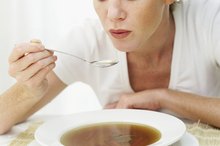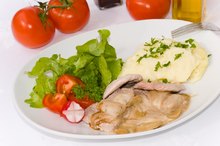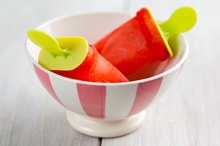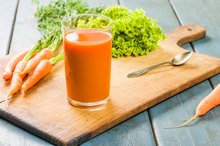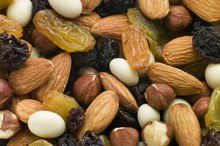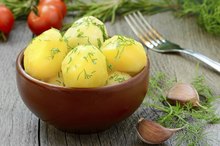List of Approved Foods for a Bland Diet
Medical professionals often suggest bland diets to those experiencing gas, ulcers, heartburn, nausea, vomiting and other conditions. A bland diet consists of low fiber, soft foods with minimal seasonings or spices, notes the University of Maryland Medical Center. Raw, fried or spicy foods are prohibited on a bland diet. As a result, the diet is designed to limit symptoms and promote recovery.
Vegetables
Vegetables are important foods to consume on a bland diet. They offer a balanced dose of antioxidants, vitamins and minerals. You should only eat frozen, canned or cooked vegetables, since the bland diet calls for soft foods. Ideal vegetables for a bland diet include winter squash, carrots, green beans, zucchini and peas. Avoid gaseous vegetables such as broccoli, onions, peppers, cabbage and cauliflower.
- Vegetables are important foods to consume on a bland diet.
- Ideal vegetables for a bland diet include winter squash, carrots, green beans, zucchini and peas.
Fruit
Soft Diet List After Bowel Surgery
Learn More
Like vegetables, fruit is a nutritious option to include in your bland diet. For easy digestion, you should choose canned, cooked or soft fruit, removing excess seeds or skin. Applesauce, fruit cocktail, bananas or canned peaches are ideal fruit-based foods for a bland diet. To extend your options, blend fruit into smoothies or juices. For best results, avoid acidic fruits, such as strawberries, blueberries, oranges and grapefruit, reports the University of Maryland Medical Center.
- Like vegetables, fruit is a nutritious option to include in your bland diet.
- For easy digestion, you should choose canned, cooked or soft fruit, removing excess seeds or skin.
Lean Meats and Fish
Lean meats and fish that are grilled without fat, steamed or baked are allowed on a bland diet. These foods contain omega-3 fatty acids and protein, which promote body repair and strengthening. Ideal meat and fish sources include tuna, mackerel, lake trout, herring, salmon, pork tenderloin, chicken breast, peeled shrimp, lobster, beef cuts and game meat.
Dairy
How to Reintroduce Solid Foods Into a Diet
Learn More
Consuming dairy products on a bland diet will supply your body with vitamin D, calcium and other nutrients. Elizabeth Lipski reports in "Digestive Wellness" that it is important to consume these sources since they are easily digested. In addition, you can easily consume them during breakfast, lunch or dinner. Dairy sources include milk, cheese, ice cream, yogurt and eggs. To avoid saturated fat, opt for reduced or low fat alternatives. Avoid strong cheeses such as Roquefort or blue cheese.
- Consuming dairy products on a bland diet will supply your body with vitamin D, calcium and other nutrients.
- In addition, you can easily consume them during breakfast, lunch or dinner.
Breads and Other Carbohydrate Sources
Breads naturally contain substantial amounts of carbohydrates, which supply your body with energy. Since white breads contain less fiber than whole grains or whole wheat bread, refined white breads are the preferred bread source while on a bland diet. Consuming low fiber foods promotes gentle movements within your digestive system. This is especially important if you are recovering from gastrointestinal surgery. Examples of breads and other carbohydrates include saltine crackers, white rice, white bread, mashed potatoes and refined hot cereals.
- Breads naturally contain substantial amounts of carbohydrates, which supply your body with energy.
- Since white breads contain less fiber than whole grains or whole wheat bread, refined white breads are the preferred bread source while on a bland diet.
Related Articles
References
- MedlinePlus: Bland Diet; Dr. George F Longstreth; May 2010
- "Digestive Wellness"; Elizabeth Lipski, Ph.D., CCN; 2005
- Vanhauwaert E, Matthys C, Verdonck L, De preter V. Low-residue and low-fiber diets in gastrointestinal disease management. Adv Nutr. 2015;6(6):820-7. doi:10.3945/an.115.009688
- Ntaba, Dziwe MD, MPH. BRAT Diet: Axiom or unsubstantiated myth? Emergency Medicine News. January 2004.
- Bland Diet. Clinical Key website. (Subscription Required). Updated June 27, 2018.
- BRAT Diet: Recovering From an Upset Stomach. Clinical Key website. (Subscription Required). Updated Aug. 22, 2017.
- Managing Your Bacterial Food Poisoning. Clinical Key website. (Subscription Required). Updated May 11, 2016.
- Moore, SW. Bland Diet. In: Moore, SW. Griffith's Instructions for Patients. 8th ed. Philadelphia, PA: Saunders Elsevier; 2011: 9-10
Writer Bio
Lee has been writing freelance articles since 2001. His articles have appeared in various newspapers, magazines and online publications such as "Orleans Daily" and the "Audubon Health Review." He holds a Master of Science in nursing administration from Tulane University.
